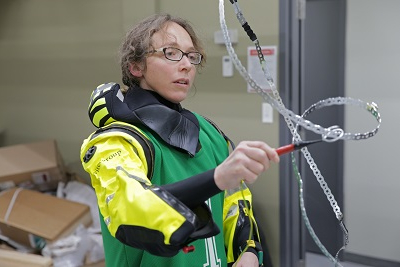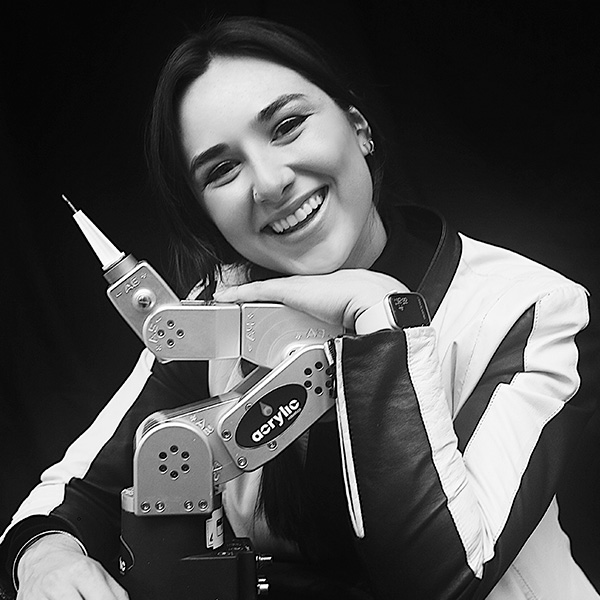We all want interesting work assignments, but the project names in our inboxes probably can’t rival what’s on Julie Bellerose’s plate.
This winter, she was wrapping up her work on DART – the “Double Asteroid Redirection Test”. Her upcoming meaty assignment? “Lunar Trailblazer”.
“The next big mission that I’m working on is a mission to the moon,” says Bellerose, BEng’03, who works at NASA’s Jet Propulsion Laboratory, the national research and development centre near Pasadena, California that is a leader in robotic space exploration.
The Montreal-area native and McGill engineering grad was the navigation team chief for DART, the ground-breaking, asteroid-diverting mission that NASA described as the “first full-scale mission to test technology for defending Earth against potential asteroid or comet hazards.”
On September 26, 2022, after four years of working on the project, Bellerose watched transfixed with her colleagues at the images relayed from DART’s spacecraft as it zeroed in on the asteroid Dimorphos. The images show the celestial object getting closer and closer and then finally, just a partial image transmitted from the spacecraft as it slammed into the asteroid.
“We were basically looking at the asteroid coming head-on,” Bellerose says. “We were glued to the screen at that point. It was pretty phenomenal.”
NASA’s first asteroid deflection test was a resounding success: the head-on collision altered Dimorphos’s orbit around its parent asteroid (Didymos), shortening the timeframe by 33 minutes.
The DART project recently earned the U.S. National Space Club and Foundation’s Nelson P. Jackson Aerospace Award, which honors the previous year’s most outstanding contribution to the aerospace field.
There is always small debris that hits – and burns in – the Earth’s atmosphere, says Bellerose. She also notes the bigger, house-sized asteroid that exploded 14 miles above Chelyabinsk, Russia in 2013, with a resulting shockwave that shattered windows over a large swath of the region.
“There’s no known object that’s coming toward us that would do big damage, but it’s not impossible,” says Bellerose. “There are some that we haven’t seen. There are some that come towards us that are not in the solar system. What the planetary defense community decided to do is not to wait for when that eventually would happen, but to try to figure out what we could do because there are a lot of things that we don’t know in terms of interacting with those small bodies.”

when she was an astronaut candidate
Credit: Canadian Space Agency
Bellerose grew up in Sainte-Julie on Montreal’s South Shore. As a teen, she was a big fan of sci-fi movies and read space-themed books, both fiction and non-fiction, by Hubert Reeves, MSc’56, Carl Sagan, Kim Stanley Robinson and others.
When Montreal native Julie Payette, BEng’86, DSc’03, joined the ranks of Canada’s astronauts, the possibility of an actual career in the aerospace field became tangible. “I think from then on, it made it more possible,” says Bellerose. (Years later, Bellerose would come impressively close to following Payette on her path. In 2016, when the Canadian Space Agency began recruiting two new astronauts, Bellerose was among the 3,772 applicants and made it to the top 32 candidates in the running.)
Bellerose graduated with honours in mechanical engineering from McGill in 2003. “I have to say the first semester was definitely very hard because of the English part of it,” she laughs. A francophone, Bellerose jokes facetiously that her grasp of English at the time was limited to ‘yes’, ‘no’, ‘toaster’.
She talked with professors during her first year, gathering information about the aerospace field. “I have fond memories of going to McGill, partly because of this openness of discussing different fields and having professors and more senior students…helping me figure out what I wanted to do later in my life.”
She went on to the University of Michigan for her master’s and PhD in aerospace engineering, followed by a year in a postdoctoral position at Japan’s space agency.
Bellerose has worked at the Jet Propulsion Laboratory for over a decade, including a long stint on the international Cassini mission, involving a space probe which orbited Saturn. Going into that assignment, Bellerose had experience in flight dynamics and mission design, but learned a lot about navigation.
DART’s spacecraft launched in November 2021 with a planned trajectory to meet up with Dimorphos on September 26, 2022. The 10-month period between launch and impact involved a lot of testing for Bellerose and her navigation team. When the probability of impact dropped substantially at one point because of certain things they hadn’t accounted for, they ran tests to figure out what they were mis-modelling and to refine software.
The pace and intensity ramped up in the final month leading to the fateful encounter because Dimorphos came into view and they could perform some approach maneuvers aimed at ensuring a very precise engagement with the asteroid. “It was extremely nerve-wracking,” Bellerose says of the home stretch. They placed many demands on the spacecraft during that phase, and it ended up using a lot of fuel, making it “move in some ways that we hadn’t predicted,” she says. But they resolved many issues about a week before impact and Bellerose slept well the night before the anticipated collision.
The spacecraft’s autopilot turned on four hours before impact. When it slammed into Dimorphos, a wave of emotions swept over Bellerose.
“I was crying after that. It was relief,” she says. “There had been so much stress in the last month. I think I went through all the possible emotions in about five minutes. I was relieved and happy but at the same time it was the end of the mission, so you feel sad because you just lost your spacecraft. It also meant that the mission was over, so all the people that you’re working with, you’re not going to work with those people anymore.”
A series of research papers published in the journal Nature last month confirmed the success of the DART mission. In a statement, Nicola Fox, associate administrator for the Science Mission Directorate at NASA, said, “These findings add to our fundamental understanding of asteroids and build a foundation for how humanity can defend Earth from a potentially hazardous asteroid by altering its course.”
Bellerose says it was a great experience to have led the DART navigation team and to be part of the historic mission. “I think we probably get lost in the technicalities of the work that we do and miss sometimes the overview, the big picture of what we work on. Especially at that moment I got a lot of press, and I was like ‘Oh, yeah, people actually care about this.’ It was great to see and be part of that.”


